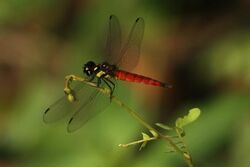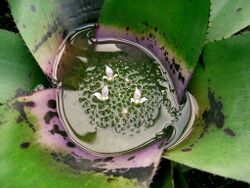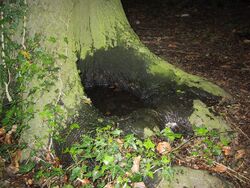Earth:Phytotelma


Phytotelma (plural phytotelmata) is a small water-filled cavity in a terrestrial plant. The water accumulated within these plants may serve as the habitat for associated fauna and flora.
A rich literature in German summarised by Thienemann (1954)[1] developed many aspects of phytotelm biology. Reviews of the subject by Kitching (1971) and Maguire (1971)[2][3] introduced the concept of phytotelmata to English-speaking readers. A multi-authored book edited by Frank and Lounibos (1983)[4] dealt in 11 chapters with classification of phytotelmata, and with phytotelmata provided by bamboo internodes, banana leaf axils, bromeliad leaf axils, Nepenthes pitchers, Sarracenia pitchers, tree holes, and Heliconia flower bracts and leaf rolls.[5][6]
A classification of phytotelmata by Kitching (2000)[7] recognizes five principal types: bromeliad tanks, certain carnivorous plants such as pitcher plants, water-filled tree hollows, bamboo internodes, and axil water (collected at the base of leaves, petals or bracts); it concentrated on food webs. A review by Greeney (2001)[8] identified seven forms: tree holes, leaf axils, flowers, modified leaves, fallen vegetative parts (e.g. leaves or bracts), fallen fruit husks, and stem rots.
Etymology
The word "phytotelma" derives from the ancient Greek roots phyto-, meaning 'plant', and telma, meaning 'pond'. Thus, the correct singular is phytotelma.
The term was coined by L. Varga in 1928.[9]
The correct pronunciation is "phytotēlma" and "phytotēlmata" because of the Greek origin (the stressed vowels are here written as ē).
Ecology
Often the faunae associated with phytotelmata are unique: Different groups of microcrustaceans occur in phytotelmata, including ostracods (Elpidium spp. Metacypris bromeliarum), harpacticoid copepods (Bryocamptus spp, Moraria arboricola, Attheyella spp.[10]) and cyclopoid copepods (Bryocyclops spp.,Tropocyclops jamaicensis[11]).[12]
In tropical and subtropical rainforest habitats, many species of frogs specialize on phytotelma as a readily available breeding ground, such as some microhylids[13] (in pitcher plants), poison dart frogs[14] and some tree frogs (in bromeliads).[15][16]
Many insects use them for breeding and foraging, for instance odonates, water bugs, beetles and dipterans.[17][18] Some species also are of great practical significance; for example, immature stages of some mosquitoes, such as some Anopheles and Aedes species that are important disease vectors, develop in phytotelmata.[4]
See also
- Nepenthes infauna
- Bromeliaceae
References
- ↑ Thienemann, A. (1954). Chironomus: Leben, Verbreitung und wirtschaftliche Bedeutung der Chironomiden. Binnengewässer 20: 1-834.
- ↑ Maguire, B. (1971) Phytotelmata: Biota and community structure. Annual review of Ecology and Systematics. 2: 439-464.
- ↑ Kitching, R. L. (1971) An ecological study of water-filled treeholes and their position in the woodland ecosystem. Journal of Animal Ecology 40: 281-302.
- ↑ 4.0 4.1 Frank, J.H. and Lounibos, L.P. (1983) Phytotelmata: Terrestrial plants as hosts for aquatic insect communities, Plexus Press. ISBN:0-937548-05-7
- ↑ Jalinsky, J., T.A. Radocy, R. Wertenberger, & C.S. Chaboo. 2014. Insect diversity in phytotelmata habitats of two host plants, Heliconia stricta Huber (Heliconiaceae) and Calathea lutea Schult (Marantaceae) in the south-east Amazon of Peru. Journal of the Kansas Entomological Society 87(3): 299–311.
- ↑ Hayford, Barbara, Timo Förster, Vivek Patel, & Caroline S. Chaboo. 2021. Aquatic Diptera associated with Neotropical Zingiberales phytotelmata (Diptera). Journal of Natural History 54:43-44, 2815-2838, DOI: 10.1080/00222933.2020.1871522.
- ↑ Kitching, R.L. (2000). Food webs and container habitats: The natural history and ecology of phytotelmata. Cambridge University Press. ISBN:0-521-77316-4
- ↑ Greeney, H.F. (2001). The insects of plant-held waters: a brief review and bibliography. Journal of Tropical Ecology 17(2): 241–260. doi:10.1017/S026646740100116X
- ↑ Varga, L. (1928). Ein interessanter Biotop der Biocönose von Wasserorganism. Biologische Zentralblatt 48: 143–162.
- ↑ Janetzky, Wolfgang; Martinez Arbizu, Pedro; Reid, Janet W. (1996-11-01). "Attheyella (Canthosella) mervini sp.n. (Canthocamptidae, Harpacticoida) from Jamaican bromeliads" (in en). Hydrobiologia 339 (1): 123–135. doi:10.1007/BF00008920. ISSN 1573-5117.
- ↑ Reid, Janet W.; Janetzky, Wolfgang (1996). "Colonization of Jamaican Bromeliads by Tropocyclops jamaicensis n. sp. (Crustacea: Copepoda: Cyclopoida)". Invertebrate Biology 115 (4): 305. doi:10.2307/3227020. ISSN 1077-8306.
- ↑ Klein, J. C. von Vaupel. (2014). Treatise on Zoology - Anatomy, Taxonomy, Biology. The Crustacea, Volume 4 Part B.. Leiden: BRILL. ISBN 978-90-04-26493-9. OCLC 883570588.
- ↑ DAS, INDRANEIL; HAAS, ALEXANDER (2010-08-19). "New species of Microhyla from Sarawak: Old World's smallest frogs crawl out of miniature pitcher plants on Borneo (Amphibia: Anura: Microhylidae)". Zootaxa 2571 (1): 37. doi:10.11646/zootaxa.2571.1.2. ISSN 1175-5334. http://ir.unimas.my/id/eprint/3386/7/NewspeciesofMicrohyla.pdf.
- ↑ McKeon, C. Seabird; Summers, Kyle (2013-06-22). "Predator driven reproductive behavior in a tropical frog". Evolutionary Ecology 27 (4): 725–737. doi:10.1007/s10682-013-9641-3. ISSN 0269-7653.
- ↑ Alves‐Silva, Ricardo; da Silva, Hélio Ricardo (January 2009). "Life in bromeliads: reproductive behaviour and the monophyly of the Scinax perpusillus species group (Anura: Hylidae)" (in en). Journal of Natural History 43 (3–4): 205–217. doi:10.1080/00222930802568808. ISSN 0022-2933.
- ↑ Sabagh, Leandro Talione; Ferreira, Rodrigo Barbosa; Rocha, Carlos Frederico Duarte (November 2017). "Host bromeliads and their associated frog species: Further considerations on the importance of species interactions for conservation" (in en). Symbiosis 73 (3): 201–211. doi:10.1007/s13199-017-0500-9. ISSN 0334-5114.
- ↑ Hayford, Barbara, Timo Förster, Vivek Patel, & Caroline S. Chaboo. 2021. Aquatic Diptera associated with Neotropical Zingiberales phytotelmata (Diptera). Journal of Natural History 54:43-44, 2815-2838, DOI: 10.1080/00222933.2020.1871522.
- ↑ Greeney, Harold F. (March 2001). "The insects of plant-held waters: a review and bibliography" (in en). Journal of Tropical Ecology 17 (2): 241–260. doi:10.1017/S026646740100116X. ISSN 0266-4674. https://www.cambridge.org/core/product/identifier/S026646740100116X/type/journal_article.
External links
 |



